The Bio-based Elastomers Market is estimated to be valued at USD 666.7 million in 2025 and is projected to reach USD 2471.6 million by 2035, registering a compound annual growth rate (CAGR) of 14.0% over the forecast period.
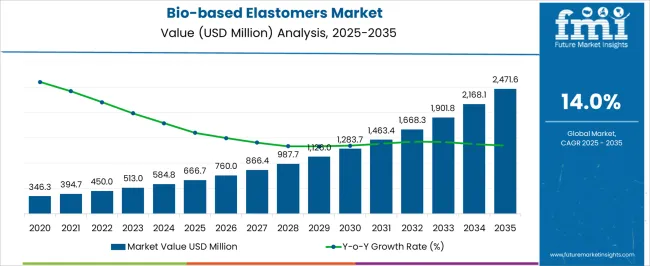
| Metric | Value |
|---|---|
| Bio-based Elastomers Market Estimated Value in (2025 E) | USD 666.7 million |
| Bio-based Elastomers Market Forecast Value in (2035 F) | USD 2471.6 million |
| Forecast CAGR (2025 to 2035) | 14.0% |
The bio based elastomers market is expanding steadily as industries transition toward sustainable material alternatives driven by environmental regulations and consumer preferences for eco friendly products. These elastomers, derived from renewable sources, offer comparable performance to conventional synthetic variants while reducing carbon footprint and dependence on fossil resources.
Industries such as automotive, footwear, and consumer goods are integrating bio based materials to align with global sustainability targets. Advances in polymer processing and feedstock optimization have improved the mechanical properties, thermal stability, and durability of bio based elastomers.
Additionally, brand commitments to circular economy practices and biodegradability standards are further accelerating the adoption of these materials. The outlook remains positive as manufacturers leverage innovation and green chemistry to deliver cost effective and high performance solutions across diverse application sectors.
The market is segmented by Product Type and Application and region. By Product Type, the market is divided into Bio-based Thermoplastic Elastomers and Bio-based Thermoset Elastomers. In terms of Application, the market is classified into Footwear, Automotive, Sports, Electrical & Electronics, and Others. Regionally, the market is classified into North America, Latin America, Western Europe, Eastern Europe, Balkan & Baltic Countries, Russia & Belarus, Central Asia, East Asia, South Asia & Pacific, and the Middle East & Africa.
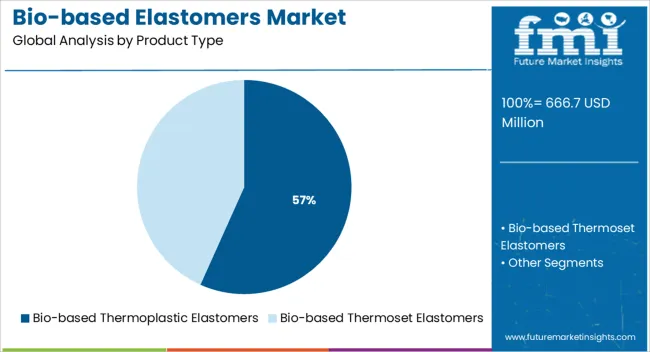
The bio based thermoplastic elastomers segment is expected to hold 56.70% of the total market revenue by 2025, making it the dominant product type. This growth is supported by its superior flexibility, processability, and recyclability compared to conventional elastomers.
Its compatibility with standard injection molding and extrusion technologies enables seamless integration into existing manufacturing lines, reducing production costs and barriers to adoption. The segment benefits from a growing demand for lightweight, durable, and eco friendly components in automotive interiors, sportswear, and industrial products.
Furthermore, ongoing innovations in bio based feedstock chemistry have enhanced thermal and mechanical performance characteristics. As a result, bio based thermoplastic elastomers are increasingly favored for their balance of sustainability, cost efficiency, and functional performance.

The footwear segment is projected to account for 38.20% of total market revenue by 2025 under the application category, establishing it as the leading segment. This is driven by rising demand for sustainable, lightweight, and durable materials in footwear manufacturing, particularly in performance and lifestyle categories.
Brands are actively shifting toward bio based elastomers to meet consumer expectations for environmentally responsible products while maintaining comfort and durability. The material’s cushioning, flexibility, and slip resistance make it ideal for midsoles, outsoles, and upper components.
Additionally, regulatory and retailer pressure to reduce product lifecycle emissions has prompted companies to substitute petrochemical based materials with renewable alternatives. The growing influence of ethical fashion and green labeling has further cemented the dominance of the footwear application in the bio based elastomers market.
The global bio-based elastomers market garnered USD 666.7 Million in 2025, expanding at a historical CAGR of 10%. Over the short term, increasing demand for Bio-based elastomers from the heating, ventilation, and air conditioning (HVAC) industry is expected to drive the market's growth.
Furthermore, in the years to come, shifting focus toward the development of bio-based products and increasing application in the fabrication of medical instruments are likely to act as opportunities. During the forecast period, the industry is also anticipated to be driven by rising expenditures on Research and Development and product development by the manufacturers. The estimation reveals that the industry is projected to secure a market value of USD 1,901.8 Million by 2035.
Growing Technology Collaboration to Aid Market Growth
The volatility in crude oil prices due to geopolitical factors has significantly contributed to developments being carried out in the market. For instance, Green Dot Plastics, based in Kansas, USA has been involved in the development of Terratek Flex GDH-B1, a starch-based bio-based elastomer formulated with 35% of bio-based content since 2011.
Although the development of bio-based elastomers presents lucrative growth opportunities, their high prices portray a significant challenge to their market growth, which can be anticipated to reduce during the upcoming years.
Technology collaboration is being observed among elastomer raw material manufacturers to develop bio-based alternatives. Such instances create a sufficient supply of bio-based raw materials, enabling adequate production of bio-based elastomers.
For instance, in May 2024, USA-based Lummus Technology entered into a cooperation agreement with Synthos to commercialize the bio-butadiene technology of Synthos for the development of bio-based butadiene, thus creating an adequate monomer supply for bio-based elastomer production.
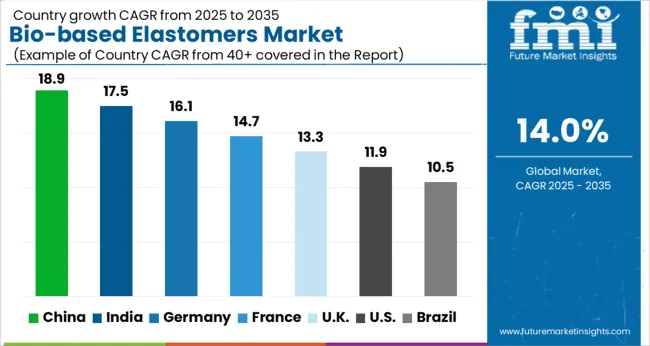
Presence of Key in the Region to Increase Consumer Demand
North America is expected to witness a growing demand for bio-based elastomers due to the presence of a significant number of bio-based elastomer manufacturers in the region. Similarly, the growing demand for electric vehicles in North America due to supportive government policies is expected to increase the demand for electric vehicle charging cables in the region, which can positively influence the consumption of bio-based elastomers in cable jackets.
The USA in North America is expected to witness significant growth in the demand for bio-based elastomers. This is due to the fact the country hosts a number of conventional elastomer manufacturers such as Avient Corporation, Huntsman International LLC, The Lubrizol Corporation, Trinseo, and Dow that are now engaged in the development of bio-based elastomers.
For instance, Dow manufactures bio-based polyolefin elastomers under the brand name AFFINITY RE. In addition, the National Biotechnology and Biomanufacturing Initiative launched by the USA Government in September 2025 to embrace bio-manufacturing to produce bio-based fuels, bio-based plastics, bio-based medicines, and other bio-based materials is expected to further contribute to the high growth of bio-based elastomers in the USA
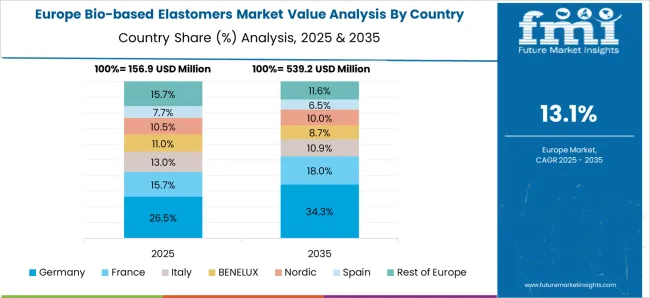
Increasing Investments in Product Penetration to Boost Regional Market
Europe accounted for the largest revenue share of more than 40.0% in 2025. Bio-Based Industries Joint Undertaking (BBI JU) was launched in 2014 between the Bio-based Industries Consortium and European Union to accelerate the consumption of bio-based content in various end-use industries.
In addition, the European Chemicals Agency (ECHA) submitted a proposal to ban rubber granules produced from end-of-life vehicle tires, which has driven tire manufacturers in Europe to consider bio-based raw materials for tire production, thus presenting a positive growth opportunity for bio-based elastomers.
In line with the current developments aimed at increasing the bio-based material content in the products, France-based tire manufacturer Michelin unveiled a plan in June 2020 to ensure 80% sustainable materials consumption in its tires by 2048.
Growing adoption in automotive applications as an alternative to conventional crude oil-based elastomers to boost the growth
The bio-based thermoplastic elastomers accounted for the largest revenue share of more than 75.0% in 2025. This is attributed to the growing adoption in automotive applications as an alternative to conventional crude oil-based elastomers with the equivalent shore hardness from 55 shore A to 80 shore A.
Some of the bio-based thermoplastic elastomers developed in the market include bio-based thermoplastic polyolefin elastomers, bio-based thermoplastic polyurethane elastomers, bio-based thermoplastic styrene block copolymer elastomers, and bio-based thermoplastic polyamide elastomers.
Bio-based thermoset elastomers include bio-based ethylene propylene diene monomers and bio-based silicone elastomers. ARLANXEO has been producing Keltan Eco EPDM commercially since 2013. The company sources bio ethylene from Braskem. The bio-based EPDM offers similar oxidative and thermal resistance properties as that of conventional EPDM, which can help it project a feasible alternative to replace conventional EPDM in the coming years.
The eco-grade silicone elastomers manufactured by Wacker Chemie under the ELASTOSIL brand offer exceptional tear resistance and are used for producing binders for the textile, paper, and consumer goods industries.
Automotive emerged as the leading application segment and is projected to dominate the market
Automotive emerged as the leading application segment and accounted for more than 35.0% share in terms of revenue in 2025. Decreasing the vehicle weight to improve fuel consumption and reducing CO2 emission are significant objectives for the automotive industry.
Thermoplastic elastomers are useful in automotive interior applications such as inlay mats, fascia, cup holder liners, and exterior windshield wipers. Materials used in automotive interiors need to meet requirements for Vehicle Interior Air Quality (VIAQ) and legislation regarding odor, fogging, and VOC. The bio-based elastomers contain a significant amount of bio-based content and exhibit a low amount of VOC, which is positively driving its consumption in the automotive industry.
Footwear emerged as the next leading application segment in 2025. The production of footwear has significant negative environmental impacts on the environment due to the use of leather, polyurethane, polyvinyl chloride, and rubber, which end up in landfills. Recently, various large sports goods brands have announced the introduction of fully biodegradable high-performance athletic footwear, which can positively influence the demand for bio-based elastomers.
For instance, Nike used 50% Pebax Renew, a castor-based thermoplastic elastomer, manufactured by Arkema that contains about 97% renewable-based components along with 50% bio-based thermoplastic polyurethanes (TPU) in its GS football boot.
Some of the key startups in the market are-
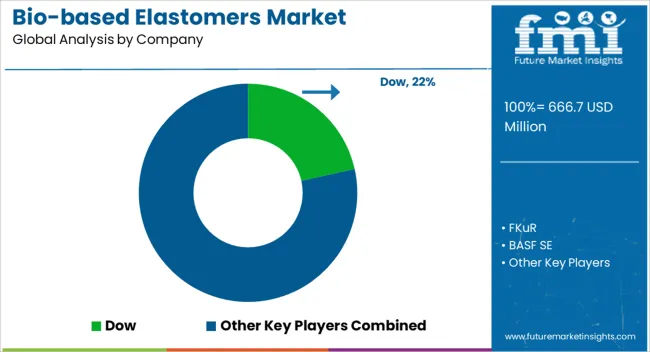
The players in the market are focusing to increase their global influence and adopt strategies such as; acquisition, collaboration, and partnerships. Some of the recent key developments among key players are:
| Report Attributes | Details |
|---|---|
| Forecast Period | 2025 to 2035 |
| Historical Data | 2020 to 2025 |
| Key Regions Covered | North America; Latin America; Europe; Asia Pacific; Middle East & Africa |
| Key Countries Covered |
USA, Canada, Brazil, Mexico, Germany, United Kingdom, France, Spain, Italy, Indonesia, Malaysia, Singapore, Thailand, China, Japan, South Korea, Australia, New Zealand, GCC Countries, South Africa, Israel |
| Key Segments Covered | Product, Application, Region |
| Key Companies Profiled | Dow; FKuR; BASF SE; ARLANXEO; Trinseo; Eni S.p.A; Asahi Kasei Corporation; DSM; Mitsubishi Chemical Europe GmbH; Arkema; The Goodyear Tire & Rubber Company; The Lubrizol Corporation; KURARAY CO. LTD.; Wacker Chemie AG; Hunstsman International LLC; Covestro AG; HEXPOL TPE; Avient Corporation |
| Pricing | Available upon Request |
The global bio-based elastomers market is estimated to be valued at USD 666.7 million in 2025.
The market size for the bio-based elastomers market is projected to reach USD 2,471.6 million by 2035.
The bio-based elastomers market is expected to grow at a 14.0% CAGR between 2025 and 2035.
The key product types in bio-based elastomers market are bio-based thermoplastic elastomers and bio-based thermoset elastomers.
In terms of application, footwear segment to command 38.2% share in the bio-based elastomers market in 2025.






Our Research Products

The "Full Research Suite" delivers actionable market intel, deep dives on markets or technologies, so clients act faster, cut risk, and unlock growth.

The Leaderboard benchmarks and ranks top vendors, classifying them as Established Leaders, Leading Challengers, or Disruptors & Challengers.

Locates where complements amplify value and substitutes erode it, forecasting net impact by horizon

We deliver granular, decision-grade intel: market sizing, 5-year forecasts, pricing, adoption, usage, revenue, and operational KPIs—plus competitor tracking, regulation, and value chains—across 60 countries broadly.

Spot the shifts before they hit your P&L. We track inflection points, adoption curves, pricing moves, and ecosystem plays to show where demand is heading, why it is changing, and what to do next across high-growth markets and disruptive tech

Real-time reads of user behavior. We track shifting priorities, perceptions of today’s and next-gen services, and provider experience, then pace how fast tech moves from trial to adoption, blending buyer, consumer, and channel inputs with social signals (#WhySwitch, #UX).

Partner with our analyst team to build a custom report designed around your business priorities. From analysing market trends to assessing competitors or crafting bespoke datasets, we tailor insights to your needs.
Supplier Intelligence
Discovery & Profiling
Capacity & Footprint
Performance & Risk
Compliance & Governance
Commercial Readiness
Who Supplies Whom
Scorecards & Shortlists
Playbooks & Docs
Category Intelligence
Definition & Scope
Demand & Use Cases
Cost Drivers
Market Structure
Supply Chain Map
Trade & Policy
Operating Norms
Deliverables
Buyer Intelligence
Account Basics
Spend & Scope
Procurement Model
Vendor Requirements
Terms & Policies
Entry Strategy
Pain Points & Triggers
Outputs
Pricing Analysis
Benchmarks
Trends
Should-Cost
Indexation
Landed Cost
Commercial Terms
Deliverables
Brand Analysis
Positioning & Value Prop
Share & Presence
Customer Evidence
Go-to-Market
Digital & Reputation
Compliance & Trust
KPIs & Gaps
Outputs
Full Research Suite comprises of:
Market outlook & trends analysis
Interviews & case studies
Strategic recommendations
Vendor profiles & capabilities analysis
5-year forecasts
8 regions and 60+ country-level data splits
Market segment data splits
12 months of continuous data updates
DELIVERED AS:
PDF EXCEL ONLINE
FKM Elastomers Market Growth - Trends & Forecast 2025 to 2035
Butyl Elastomers Market-Trends & Forecast 2025 to 2035
Recycled Elastomers Market Size and Share Forecast Outlook 2025 to 2035
Olefinic Thermoplastic Elastomers Market
Chlorinated Polyethylene Resins and Elastomers (CPE) Market Size, Growth, and Forecast for 2025 to 2035
Demand for Biobased Biodegradable Plastic in Japan Size and Share Forecast Outlook 2025 to 2035
Demand for Biobased Biodegradable Plastic in USA Size and Share Forecast Outlook 2025 to 2035
Biobased Binder for Nonwoven Market Size and Share Forecast Outlook 2025 to 2035
Biobased And Synthetic Polyamides Market Size and Share Forecast Outlook 2025 to 2035
Biobased Polypropylene PP Size Market Size and Share Forecast Outlook 2025 to 2035
Biobased Degreaser Market Size and Share Forecast Outlook 2025 to 2035
Biobased Biodegradable Plastic Market Growth - Trends & Forecast 2025 to 2035
Biobased Propylene Glycol Market Growth - Trends & Forecast 2025 to 2035
Biobased Transformer Oil Market

Thank you!
You will receive an email from our Business Development Manager. Please be sure to check your SPAM/JUNK folder too.
Chat With
MaRIA